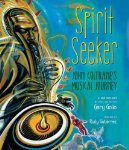Through the Looking Glass Children's Book Reviews
Spirit Seeker: John Coltrane's Musical Journey
Illustrator: Rudy Gutierrez
Nonfiction Picture Book
For ages 7 to 9
Clarion Books, 2012 ISBN: 978-0547239941
When John Coltrane was a boy, his life “was like a little slice of heaven.” He lived in his grandfather’s house with his parents, his grandparents, his aunt and his cousin. His father was musical and he charmed friends and family members with his ukulele and violin playing. Then, just before Christmas, when John was twelve, his beloved grandfather died, and just three weeks later John’s father died. In the spring Grandma died.
John and his remaining family members reeled under the weight of their losses. They did not have the luxury to grieve though. They had to go to work, including John, and they took in boarders. John took refuge in music, soaking up the sound of Lester Young’s tenor saxophone. Lester played with Count Basie, one of the few African-American bandleaders around at that time.
When John went to high school he joined the community band, learning how to play the alto saxophone on a used instrument. He practiced for hours letting his instrument “become his voice.”
When John left high school he went to Philadelphia where he worked in a factory and lived with his aunt and cousin. One day his mother brought him a new saxophone, and John began to take music classes, learning everything he could about music. His work paid off and John began to play with “big bands and small blues groups.” When he went on tour, John got lonely and depressed. Even when he was given splendid opportunities to play with famous bands, John struggled, seeking solace by drinking or by taking drugs. He sank further and further into the abyss of despair and then, finally, he asked for help and he was able to turn back to the light and back into the world of music.
In this remarkable book the author tells the story of one of the world’s greatest musicians. He explores John Coltrane’s inner struggles, and readers come to see that Coltrane was a deeply religious man, a man who wanted to use his music to help him and others to connect with the divine. Gary Golio beautifully describes how Coltrane battled with his demons, and eventually found peace.
At the back of the book there is an afterword, an author’s note, and an artist’s note. These three pieces of text provide more information about John Coltrane, his life, and his legacy.




